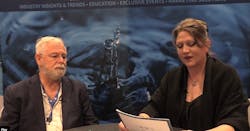TROY, NY, MARCH 12, 2020 -- Tens of thousands of reservoir and dam systems are being operated in communities across the United States, ensuring access to reliable sources of water. That access, however, isn’t a guarantee. Altered rainfall patterns driven by global warming, increased urbanization, and growing populations are setting up parallel increases in demand for water and energy.
Sustainable approaches to managing these systems are a critical part of the solution. To that end, mechanical engineers at Rensselaer Polytechnic Institute are developing a better understanding of how water and sediment flow through reservoirs and dams, in the hopes of making that process closer to earth’s natural dynamics. Their work is being supported by a National Science Foundation Faculty Early Career Development (CAREER) grant.
“My motivation is to have this broad impact on communities and humanity,” said Mamadou Diagne, an assistant professor of mechanical, aerospace, and nuclear engineering at Rensselaer, who has been awarded this grant.
Diagne’s research focuses on developing innovative and highly advanced controllers for dynamic systems described by partial differential equations at a fundamental level. Model-based controllers determine how critical variables can be manipulated, in real time, to steer an entire system’s dynamic. That level of control depends upon available measurements using adequate sensing mechanisms.
For this research, he and his team are looking specifically at reservoir sedimentation — a challenge that is created when networks of dams change the natural flow of water from rivers to the sea.
“A substantial volume of the sand that was transported to the sea is now stuck somewhere in reservoirs. This is a huge problem that is deleterious to ecological stability of rivers and reduces the capacity of reservoirs in the long run,” Diagne said.
Over time, as sediment and organic debris build up, reservoirs lose capacity and run the risk of becoming toxic. Developing a strategy for flushing out that sediment in an ecologically friendly way — one that even preserves the natural flow of water — could be a solution.
“How can we enable fast and continuous flushing of sediment so we can operate the dam while preserving the natural course of things?” Diagne said.
To try and answer that question, the researchers are working to develop new models and control algorithm theories to understand the problem better. They will then build an experimental setup in the Center for Flow Physics and Control at Rensselaer to test their theories.
Diagne’s students will also develop a prototype to represent this research for the Schenectady Museum of Innovation and Science. Diagne hopes to educate the public about the need for environmentally friendly solutions to managing reservoirs and dams on a global scale.
To learn more, visit www.rpi.edu.
SOURCE: RPI



